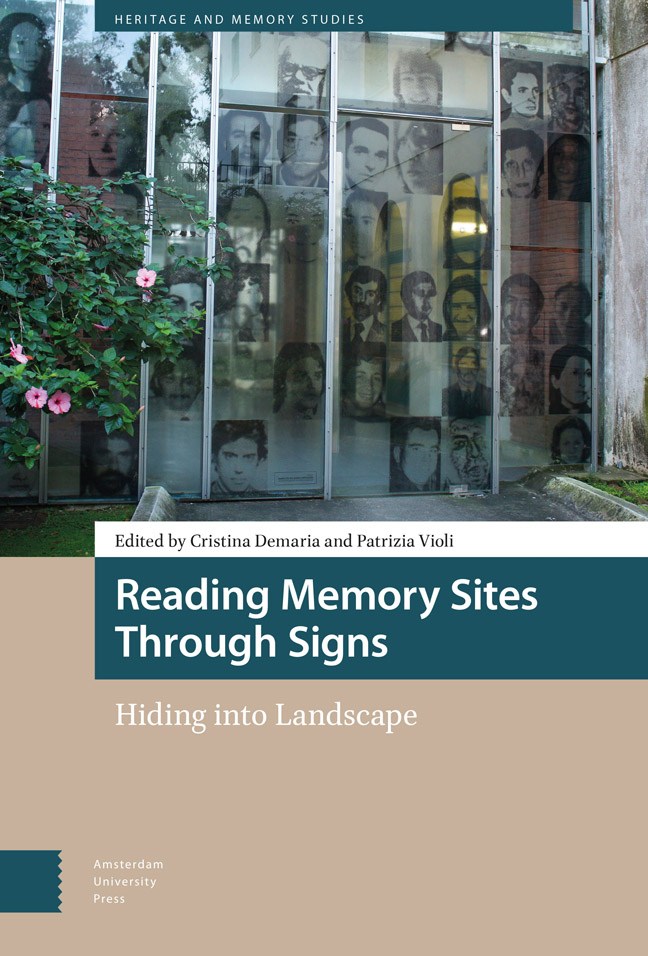Book contents
- Frontmatter
- Contents
- List of Illustrations
- For a Semiotics of Spaces of Memories: Practices of Enunciation and Narratives from Monuments to Global Landscapes of Inheritance
- 1 Stories that Shape Spatialities: Lieu and Milieu de Mémoire through the Lens of Narrativity
- 2 Interpretation and Use of Memory: How Practices Can Change the Meanings of Monuments
- 3 Uncomfortable Memories of Fascist Italy: The Case of Bigio of Brescia
- 4 What Does Fascist Architecture Still Have to Tell Us?: Preservation of Contested Heritage as a Strategy of Re-Enunciation and ‘Voice Remodulation’
- 5 Berlin, the Jewish Museum and the Holocaust Memorial
- 6 Making Space for Memory: Collective Enunciation in the Provincial Memory Archive of Córdoba, Argentina
- 7 Ruins of War: The Green Sea and the Mysterious Island
- 8 Turning Spaces of Memory into Memoryscapes: Cinema as Counter-Monument in Jonathan Perel's El Predio and Tabula Rasa
- 9 Voices from the Past: Memories in a Digital Space: The Case of AppRecuerdos in Santiago, Chile
- 10 500,000 Dirhams in Scandinavia, from Mobile Silver to Land Rent: A Semiotic Analysis
- Index
- Index of Names
5 - Berlin, the Jewish Museum and the Holocaust Memorial
Published online by Cambridge University Press: 17 February 2024
- Frontmatter
- Contents
- List of Illustrations
- For a Semiotics of Spaces of Memories: Practices of Enunciation and Narratives from Monuments to Global Landscapes of Inheritance
- 1 Stories that Shape Spatialities: Lieu and Milieu de Mémoire through the Lens of Narrativity
- 2 Interpretation and Use of Memory: How Practices Can Change the Meanings of Monuments
- 3 Uncomfortable Memories of Fascist Italy: The Case of Bigio of Brescia
- 4 What Does Fascist Architecture Still Have to Tell Us?: Preservation of Contested Heritage as a Strategy of Re-Enunciation and ‘Voice Remodulation’
- 5 Berlin, the Jewish Museum and the Holocaust Memorial
- 6 Making Space for Memory: Collective Enunciation in the Provincial Memory Archive of Córdoba, Argentina
- 7 Ruins of War: The Green Sea and the Mysterious Island
- 8 Turning Spaces of Memory into Memoryscapes: Cinema as Counter-Monument in Jonathan Perel's El Predio and Tabula Rasa
- 9 Voices from the Past: Memories in a Digital Space: The Case of AppRecuerdos in Santiago, Chile
- 10 500,000 Dirhams in Scandinavia, from Mobile Silver to Land Rent: A Semiotic Analysis
- Index
- Index of Names
Summary
Abstract
In this contribution, I discuss two places of memory in Berlin: the Jewish Museum, designed by the architect Daniel Libeskind (2001), and the Holocaust Memorial, designed by Peter Eisenman (2005), that have become well-known landmarks of the German capital, both for the importance of the subject matter and for their decidedly innovative architectural quality. The comparative analysis I propose focuses in particular on the visitor paths that architectural morphologies prompt and at times prescribe. Where the Jewish Museum induces memory through an obligatory sensorial path, the Holocaust Memorial leaves the visitor freer to move around the large esplanade on which it stands, suggesting more general reflections on the communication strategies of spatial artefacts and on their effectiveness.
Keywords: Places of Memory; Contemporary Museums; Urban Identity; Sensory Paths; Spatial Effectiveness; Free Interpretation.
The Places of Memory
In this contribution, I will discuss two places of memory: the Jewish Museum and the Holocaust Memorial, both shrines to the same story, both in Berlin, both designed by two important architects: the first by Daniel Libeskind, the second by Peter Eisenman, with a very different slant, obviously linked to the specificity of the proposed theme and the personality of the two designers, but also to the type of interpretation to which these places are subjected by the public. Both were inaugurated in the early twenty-first century (2001, 2005), and both have become well-known landmarks of the German capital, essential tourist destinations. In this sense, the absolute, disruptive novelty that they represented in many aspects has perhaps faded over time, and their very persistence has partly tarnished the strength of the architectural ‘gesture’ they represent. But this is probably the destiny of every monument, a sign of memory, a reminder of the past immersed in turn in the flow of time and its changes, as a recent book edited by Anne Beyaert also demonstrates with a wealth of examples (Beyaert-Geslin 2019).
All museums are places of memory to some extent, but only a few are explicitly dedicated to the memory of a specific event. The construction of a monument or memorial expresses the need to identify ‘memory stabilisers’, which Aleida Assmann has broken down into the categories of affection, symbol and trauma (Assmann 1999).
- Type
- Chapter
- Information
- Reading Memory Sites through SignsHiding into Landscape, pp. 141 - 162Publisher: Amsterdam University PressPrint publication year: 2023

